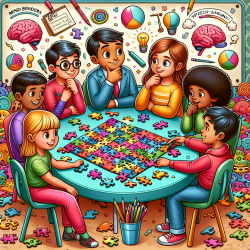As Special Education Directors, we are constantly seeking innovative ways to support our students, especially those facing language impairments. A groundbreaking study titled Expressive Language and Perceptual and Motor Abilities in Language-Impaired Children sheds new light on the intricate relationship between expressive language development and perceptual and motor abilities in children with Specific Language Impairment (SLI). This research offers valuable insights for practitioners aiming to refine their therapeutic strategies to better serve our students.
The study investigates the correlation between expressive language abilities and various perceptual and motor skills in children with SLI compared to their normally developing peers. The findings suggest that in children with SLI, expressive language capabilities are closely linked with their auditory processing abilities, particularly the processing of speech sounds and the sequencing of movements. This connection is less pronounced in children without language impairments, indicating a unique challenge faced by children with SLI.
For practitioners, these insights emphasize the importance of incorporating auditory processing and motor sequencing exercises into therapy sessions for children with SLI. By focusing on these areas, therapists can directly address the underlying difficulties these children face in developing expressive language skills. Here are some practical ways to implement the outcomes of this research:
- Enhanced Auditory Processing Activities: Incorporate activities that challenge the child to identify, discriminate, and sequence speech sounds more effectively. This could include games that require quick responses to auditory cues or the use of technology-based auditory training programs.
- Motor Sequencing Exercises: Engage students in tasks that require sequential motor responses, such as rhythm-based activities or sign language. These exercises can help improve the coordination between perception and motor output, which is crucial for speech production.
- Integrated Perceptual-Motor Tasks: Design therapy sessions that combine auditory processing and motor sequencing. Activities like speaking in rhythm to a beat or interactive computer games that require responses to auditory stimuli can be particularly beneficial.
- Customized Intervention Plans: Use the detailed findings of the study to tailor intervention plans to the specific needs of each child. By understanding the particular perceptual and motor challenges a child faces, therapists can more effectively target their therapy.
This research also underscores the need for ongoing assessment and adaptation of therapy plans. As children make progress, their perceptual and motor abilities will evolve, necessitating adjustments to the therapeutic approach to ensure continued progress in expressive language development.
Furthermore, the study highlights the importance of interdisciplinary collaboration in supporting children with SLI. Speech-language pathologists, occupational therapists, and special education teachers can work together to create a cohesive and comprehensive therapy plan that addresses the full range of challenges these children face.
In conclusion, the Expressive Language and Perceptual and Motor Abilities in Language-Impaired Children study offers crucial insights for improving therapy for children with SLI. By integrating the research findings into practice, therapists can enhance their approaches, leading to more effective support for our students' expressive language development. As Special Education Directors, it is our role to ensure that our staff is equipped with the latest research and tools to best serve our students. Encouraging further research and professional development in this area will continue to advance our collective understanding and therapeutic practices.
To read the original research paper, please follow this link: Expressive Language and Perceptual and Motor Abilities in Language-Impaired Children.










